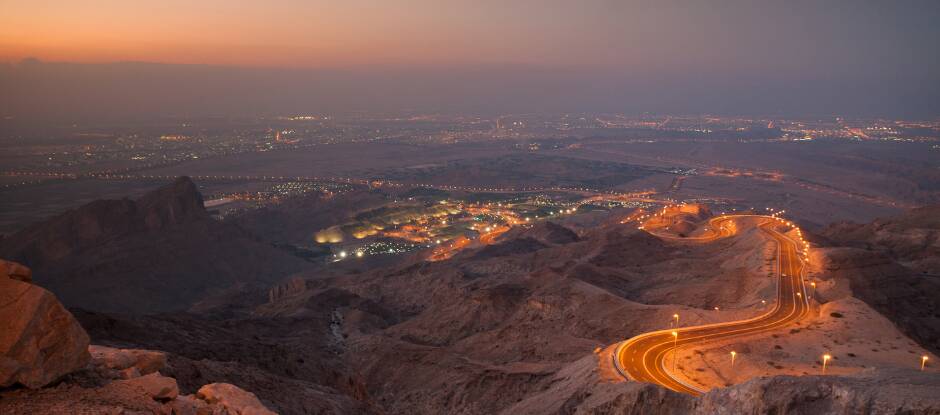With the second annual edition of Middle East & North Africa’s 50 Best Restaurants coming to the UAE capital on 30th January 2023, we are exploring Abu Dhabi and the surrounding region’s culinary history. Local food writer Kathy Johnston takes you on a trip through time illustrated by the indigenous dishes of this fragrant fragment of the Middle East
Fifty years ago, vast swathes of the UAE were nothing but sand. Sprawling metropolises have since sprung up out of the baron landscape, creating some of the most advanced cities on the planet. In Abu Dhabi, the population of just under two million are fed by just shy of 1,000 restaurants, featuring myriad cuisines, both international and local. In recent years, a boom in authentic Emirati food has come to the fore.
Historically, these dishes are infused with spices traded via the camel caravans, sweetened with locally harvested dates and full of the cultural codes and adventures of Bedouin tribes. Taking it right back to the city’s genesis, English explorer Wilfred Thesiger and his Bedouin companions had gone weeks without a meal during his famous crossing of the Empty Quarter towards Abu Dhabi’s Liwa Oasis in 1945. 
Bedouin travellers crossing the desert sands
He walked across baking desert sand together with a tribe of determined Bedouin and their camels, loaded with sacks of their mainstay ingredients: flour, coffee, ghee and dates. Most meals consisted of rustic flatbread, made with the smallest amount of their most prized store – water.
The group were ecstatic to catch a rabbit one evening and began preparing it. Over the fire, the meat was slowly roasted, fat sizzling as it landed on hot coals. Despite not having meat for a month, the legendary diyafa (generosity) of these desert tribes determined that a group of unexpected strangers who came across their hungry group were ultimately the lucky recipients of the rabbit.
Arriving today in Abu Dhabi – or even the remote Liwa Oasis – a visitor finds a menu vastly different from the one shared on that night, although still served together with the same cultural codes of these desert nomads: pride, hospitality and above all, resourcefulness. 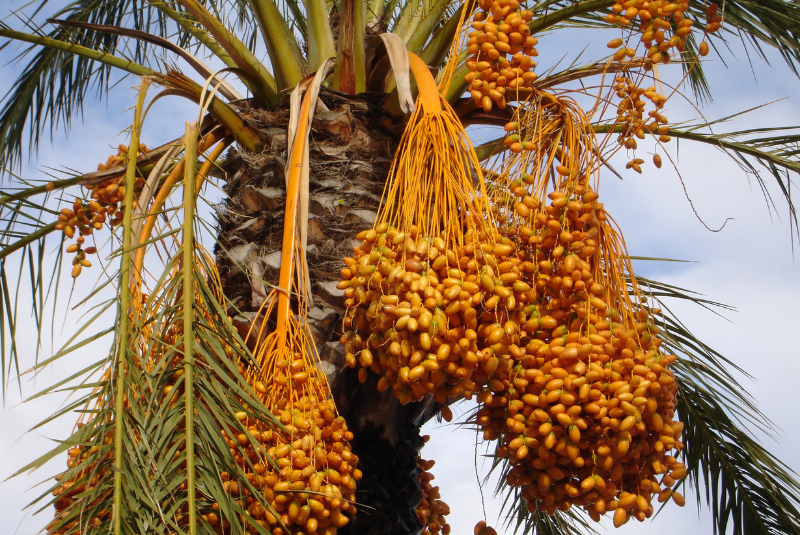
Dates, which grow on large palms, were popular among Bedouin travellers and are still grown in abundance today
Pre 1950: The Bedouin Era
The Bedouin communities of the Abu Dhabi mangrove wove thick dark fabrics from the hides of goats, to construct communities of tents that were grouped together by palm frond walls designed to protect their valuable animals. Decorated clay pots up to a metre tall were used to store their treasured date harvest year-round and to transport them if the group uprooted.
While there are more ancient stories of the Bedouin in the Emirates, the most significant to the settling of the UAE’s capital city was the relocation of the Al Nayhan tribe – who would go on to become the ruling family – to the main island, from the Al Ain oasis in the late 1790s, persuaded by a discovery of plentiful fresh water in Abu Dhabi.
Mohammed Kazim, an Emirati researcher specialising in the culture of the Arabian Peninsula who guides small groups into rarely seen communities, explains: “There’s very little written records of what was being eaten at that time. We know that in mountain areas and rocky plains they were able to grow barley, wheat, and millet, as well as rice in Asir and the Al Ahsa Oases.
“The exact dishes varied from place to place. You could expect that meat (goat, sheep or camel) would only be typical of meals for special occasions – Eid or a wedding, served together with rice, bread or dough soup. These were dishes like haneedh (slow-roasted lamb stew), fogah (fish with rice and citrus) and tahta (layers of salty fish with rice). Honey would sometimes be added to the meat and rice in the mountain terrain, with certain herb-like shrubs used for flavour, such as wild zaatar, sheeh (wormwood) or bardagoosh (marjoram).”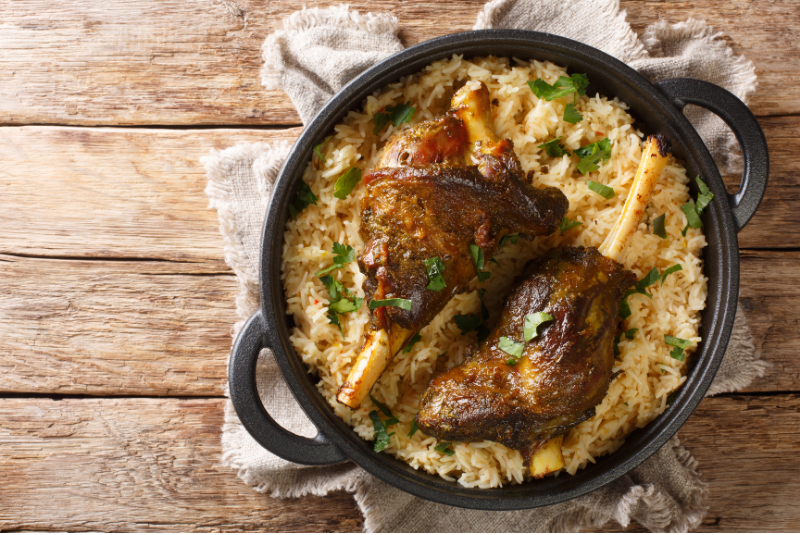
A dish of hannedh, slow-roasted lamb stew on a bed of rice
Using bags made with animal skins to churn milk, limited dairy products were also possible, including laban (buttermilk), samn (ghee) and zibdeh (butter). Meals were always homemade. Led by the women of each tribe, they cooked the stews and baked the breads over fires within a curtained off area of the family tent dedicated to cooking. Recipes were passed down through the simple process of generations working together, learning from one another.
1970s: Formation of the Union
The menu for nomadic Bedouin tribes did not change for hundreds of years: dates, laban, rice, fish, goat and once every now and then, an exotic spice that appeared on the horizon aboard a dhow sailing up from Zanzibar (once ruled by neighbouring Oman).
As more traders had been sailing by the coastal communities of the Emirates, souks were established for the fisherman, spice traders and local farmers to sell their goods – and cafeterias opened to serve the visiting traders. Emirati dishes such as ragag (crispy flat bread with cheese, honey or date syrup), chebab (pancakes) and balaleet (omelette with vermicelli noodles) were sold in these markets by entrepreneurial women, alongside more fragrant dishes from visiting traders. 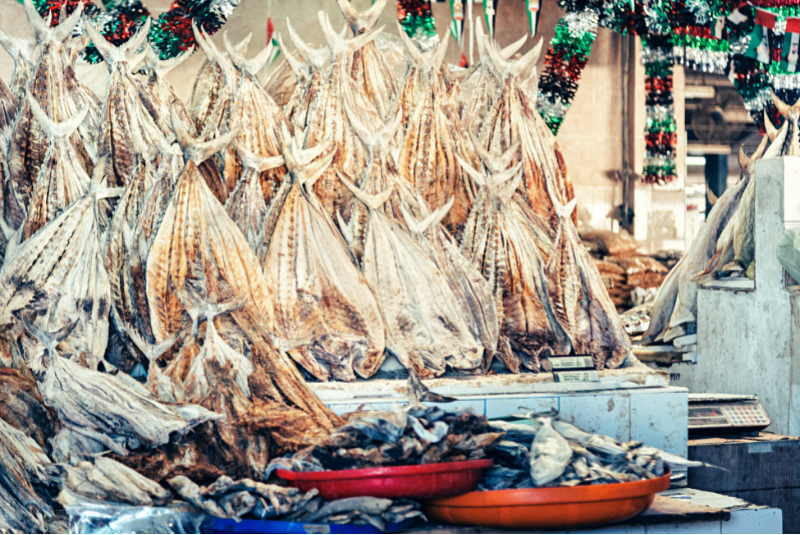
Fishermen sell their produce at local markets across the United Arab Emirates
Enduringly popular for breakfast across the Emirates, these dishes can be found from both busy roadside cafeterias, and five-star hotels in Abu Dhabi encouraged by the support of the government-led Emirati Cuisine Program. Cooked from a yellow batter (infused with turmeric and cardamom), chebab pancakes are drizzled with date syrup and sometimes folded over cream cheese. Al Fanar Restaurant in Abu Dhabi has developed a reputation for its signature Emirati breakfast platter, which features an authentic selection of chebab, balaleet and local breads.
A new world of flavour began to slowly open, with cinnamon, saffron, turmeric, chilli and nuts readily available, quickly updating the flavours of local food. Preserved, canned and packaged foods were also coming into port. Fruits and vegetables such as coconut, dried beans and herbs were responsible for another layer of the evolutionary story.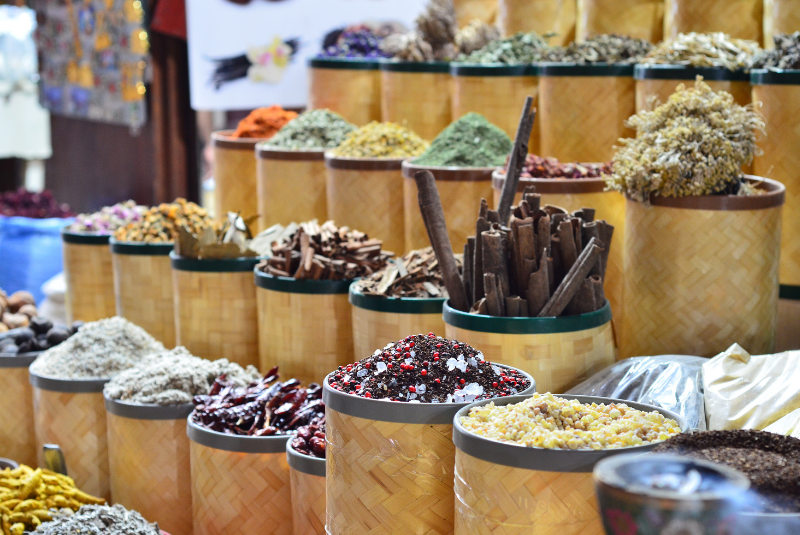
A vast array of spices are sold at local markets, including cinnamon, saffron and turmeric
1990-2010: High Speed Food
The evolution from Emirati towns into cities saw its peak in the 1990s and early 2000s. Exciting, foreign concepts arrived that reflected every corner of the world. Korean, Ethiopian, Irish, Pakistani and Filipino restaurants popped up with great success. During this period, pretty much the only way to enjoy an authentic Emirati cuisine experience was to be invited to an Emirati home for Friday lunch.
Within a modern Emirati home, there are usually a small number of branches of the family living together and the women gather to proudly work together to prepare classic dishes every weekend for their families, eaten in the same way as their Bedouin forefathers, which is every Friday after prayer, sitting on the floor around a buffet of food on generous platters.
Even during this time of international expansion, authentic Emirati dishes were cooked using the same techniques, at home, for special occasions. Home-cooked favourites included thabeeha (a whole goat cooked over spiced rice and served with broth and laban), aseeda (pumpkin cooked with roasted flour, cardamom and ghee) and machbous (fish or goat, loomi and tomato stew served with rice).
To ensure visitors were able to experience Emirati cooking themselves, the Sheikh Mohammed Centre for Cultural Understanding was opened in 1998 in one of Dubai’s oldest districts, providing an opportunity to experience the private life of an Emirati family. Thousands of visitors have participated in one of their meal experiences, hosted in an original Al Fahidi district windtower villa. 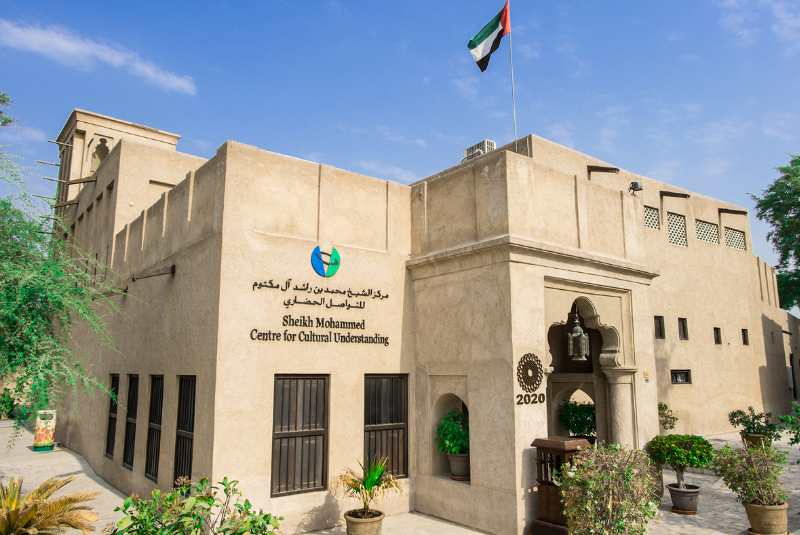
The exterior of the Sheik Mohammed Centre for Cultural Understanding in Dubai
2010-2020: Preservation
The privacy of the Emirati family unit kept alive the recipes of the past and protected these characterful dishes from adapting into contemporary parts of modern life. Hotels wanting to offer holidaymakers some Emirati dishes had already started to offer balaleet and ragag at breakfast buffets and ‘Arabic’ restaurants were including a short section of Emirati dishes the menu amidst favourites from Syria, Lebanon and Iraq.
Though much fewer in number, independent restaurants started to focus more on offering the Bedouin dishes created during those early days of the Emirates. Al Fanar (with Bedouin tent style set up), Al Arish (one of the oldest, located at the Abu Dhabi fish market) and for something with a little luxury, Mezlai at The Emirates Palace presents a fine dining approach. 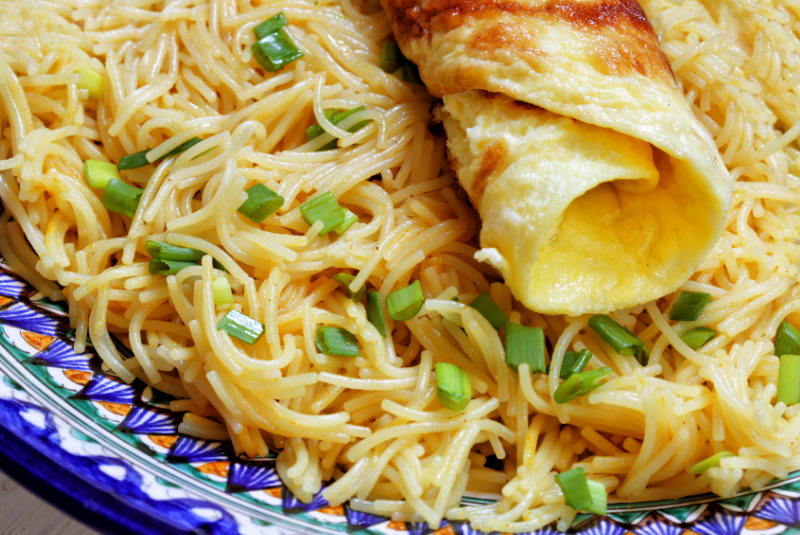
Balaleet, made with vermicelli noodles, sweetened with sugar, cardamom, rose water and saffron, topped with an omelette, is a popular breakfast dish
Founder of Lento restaurant in Abu Dhabi, Faisal Naser was studying science in England when he started to think about turning his cooking hobby into a career. “I wasn’t able to tell my parents that i was working part time in restaurants in the UK and wanted to take it more seriously,” he says. “When i went to England to study genetics, I was cooking Emirati food for other Arab students who were missing home - but cooking was just for home.
“In the kitchen, time passed and i never felt it. I could express myself artistically and scientifically. With the help of social media, it saw a gradual acceptance of Emiratis working in the kitchen and eventually it took over my full time job.”
Chef Naser has found various ways to integrate what he learnt from his grandmother’s generation into his cooking. “A very Bedouin technique i learnt at my father’s side was the process of hanging to dry an animal after slaughtering to achieve more tender meat and crispier skin. I’ve also been able to source a type of thoom jabaly (mountain garlic) that i use in pickling, and still use loomi (dried limes) with a microplane to add a citrus fragrance to finish dishes.”
His casual restaurant in Abu Dhabi serves mostly burgers to the customers willing to queue up for them, made with a blend of 34 spices and served in Hokkaido milk buns, staying true to its roots, but with one eye on the future.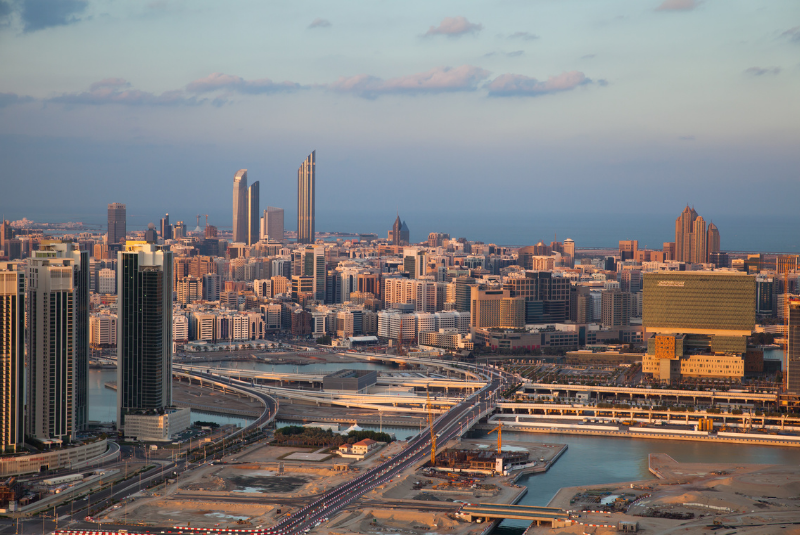
The Abu Dhabi skyline has risen quickly over the past decades
2021 and beyond
With few ingredients to call on and challenging conditions, an Emirati cookbook of historical recipes would be a short read, but given the massive cultural shift opening the path for young chefs, it’s perhaps too soon to pigeonhole Emirati cuisine.
The support from all residents towards the UAE’s governing bodies is strong because of the genuine efforts made over many decades to facilitate the success of the country, whether you are just passing through, or part of an ancient Bedouin tribe.
Exceptionally well-travelled, the nomadic spirit of the Bedouin remains present in local communities. Emiratis have explored every corner the world, travelling abroad for education as well as adventure and returning home full of inspiration. Independent, proud and resourceful, many restaurants have already been opened by enthusiastic Emirati entrepreneurs, as have dozens of speciality coffee roasters, keeping hold of the gahwa coffee ritual and ceremony.
The Abu Dhabi Agriculture and Food Safety Authority was established in 2005 to further diversify the agriculture, aquaculture, honey and food output, alongside similar ambitious projects in other Emirates. Hydroponic vertical farms have been established in the centre of Dubai, growing premium quality greens and raspberries, extending the ‘UAE Grown’ section of online green grocer delivery services to match that of the imported options.
High-profile pastry chef Sahar Al Awadhi has been a leading example for the local community of a woman succeeding in a relatively new career path for Emiratis as she took over the ovens at Dubai’s Burj Al Arab Hotel. “There's huge potential and room for the cuisine of the UAE to be developed and revolutionised. When we think of French pastry, for example, we now use new techniques to modernise pastry to what we know it as today."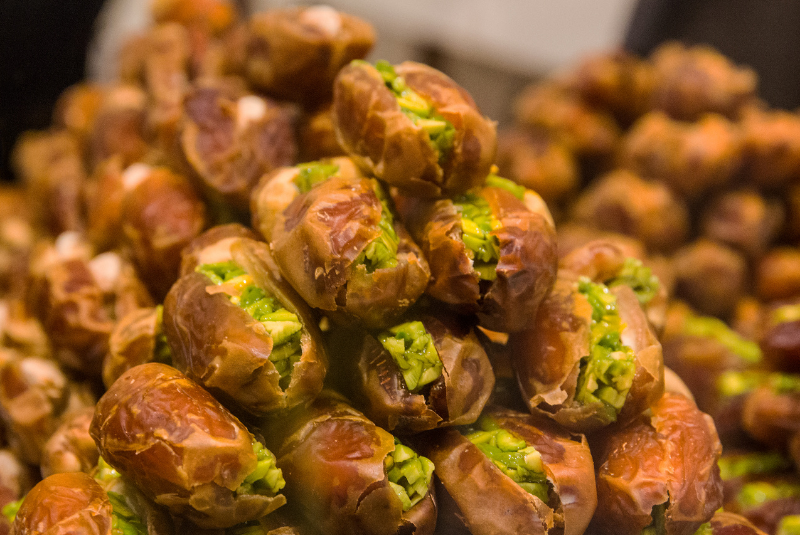
A popular sweet dish of Barhi dates stuffed with pistachios
Having learnt many Emirati recipes from her family, Al Awadhi believes the value of gathering techniques and recipes directly from the source, has deep benefits. “Our distinctive advantage being that we have almost first hand access to that knowledge or information from our mothers, aunts, grandmothers who are still making the traditional recipes, the traditional way. We can all do our part to adapt those recipes and that's how I see 2030 looking for us. Preserving the essence of the dish, not compromising its flavour, and revolutionising the way it's prepared and presented.”
Inspired by their parents' home cooking and with more than a little nod to the past, ambitious and exciting young cooks from across the UAE are taking steps towards writing an new edition of the Emirati Cookbook.
Excited to attend the events in Abu Dhabi? Full details – including dates, timings, exact locations and ticket prices, as well as other participating chefs – will be announced in the coming weeks. Meanwhile, visit the MENA’s 50 Best Restaurants website to discover how the list is being created and join the community on Instagram, Facebook, Twitter and YouTube to be the first to hear about the latest news and announcements.
